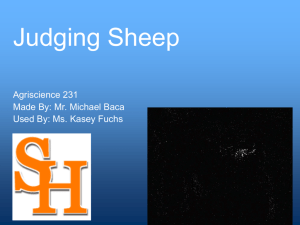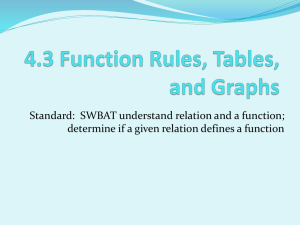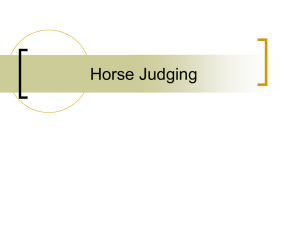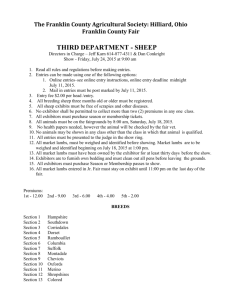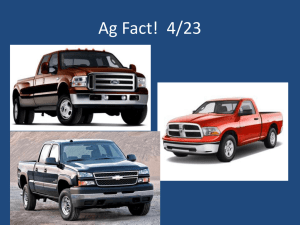AG 12.5 - Intro to Livestock Judging
advertisement
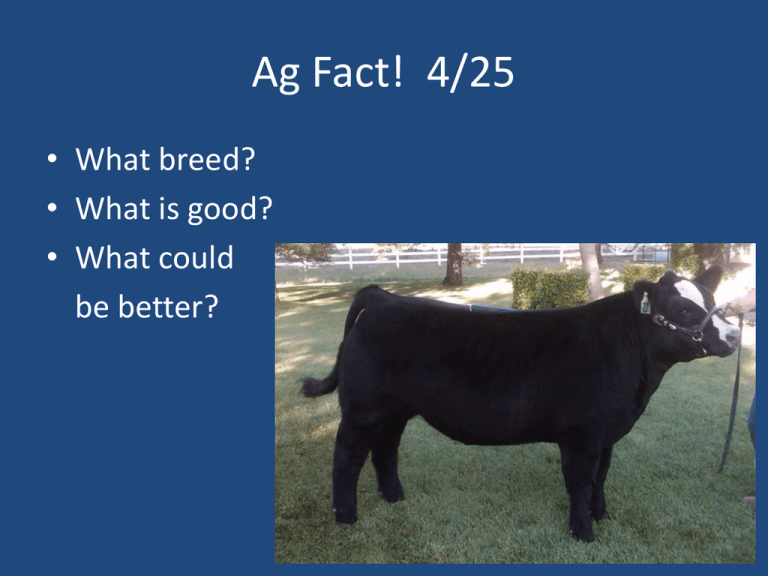
Ag Fact! 4/25 • What breed? • What is good? • What could be better? Livestock Judging 1.0 Sheep Sutherlin AST Adapted from University of Kentucky Judging PowerPoints and Georgia Ag Ed Steps to Judging Sheep 1. Evaluate animals from the ground up and from the butt (rear) forward 2. Rank the traits for their importance 3. Evaluate the most important traits first 4. Eliminate any easy placings in the class 5. Place the class based on the volume of the important traits Ranking of Traits for Market Lambs 1. 2. 3. 4. 5. Degree of muscling Degree of finish Balance and style Frame size Soundness and structural correctness Ranking of Traits for Breeding Ewes 1. 2. 3. 4. 5. 6. 7. Style and balance Frame size Soundness and structural correctness Capacity or volume Degree of muscling Degree of leanness Wool Evaluate Degree of Muscling To evaluate degree of muscling, pay close attention to: 1. Thickness through the center of the leg 2. Width between the rear legs when the animal is on the move 3. Length of the hindsaddle 4. Width and length of the loin 5. Grooved shape over the rack Evaluating Degree of Muscling - Center Leg and Base Width Light muscled (narrow) Average muscled (average width) Heavy muscled (wide) Evaluating Degree of Muscling - Width and Length of Loin A wide loin is desired in market lambs A long loin is desired in market lambs Evaluating Degree of Muscling - Length of Hindsaddle - Hindsaddle Foresaddle Greater length of hindsaddle (relative to the foresaddle) is desired in sheep Evaluating Degree of Muscling - Shape Over Rack - Rack Grooved shape over the rack is desired in sheep Evaluate Finish 1. Lambs should be lean with an ideal backfat thickness of 0.15 to 0.20 inches 2. Degree of muscling, frame size, and stage of maturity influence degree of finish – Watch out for short, light muscled lambs – Fat sheep will be widest over the top 3. Lambs that are lean will be: – Very trim over and behind the shoulder – Extremely clean and neat through underline Evaluate Finish Flat, wide top Fat Alert !! Heavy fronted Sloppy, loose middle Good rule to follow: Fat sheep go last in the class Evaluate Finish Ideal finish Lamb is very trim with base width is at least as wide as width of top Evaluate Finish Clean and trim over and behind shoulder Ideal finish Trim and neat through underline Evaluate Balance and Style Balance deals with having equal portions of width, depth, and length, with special emphasis on length: • Sheep should be wide and deep at the rear and tight and trim through the front-end (Christmas tree shape) • Volume of weight in leg and loin Evaluate Balance and Style Style deals with correctness of structure and straightness of design: • A straight top line is desired • A neat, smooth shoulder that blends smoothly into the neck and ribs is desired Evaluate Balance and Style Broken topped Steep rumped Heavy fronted Deep necked Too heavy through middle Low necked Nasty Sheep Alert !! (no balance) Evaluate Balance and Style Unbalanced Wrong angle: heavier in the front half than in the rear half Evaluate Balance and Style Nice balance Evaluate Balance and Style Neck too deep and low in its placement Poor Style Too open shouldered Weak topped Steep rumped Evaluate Balance and Style Good style points Level rump Straight top line Very high, correct neckshoulder connection Evaluate Balance and Style Smooth at point of shoulder Good Style Points! Very high set to neck Clean, flat breast Tight over shoulders, correct angular shape Evaluate Soundness and Structural Correctness When evaluating soundness and structural correctness, pay close attention to: 1. Feet and pasterns 2. Hocks 3. Knees 4. Rumps 5. Shoulders Evaluating Soundness - Feet and Pasterns Not good Too much set to pastern Poor depth of heel (hoof- skin junction too low) Cripple Alert ! Extreme set to pastern Very poor depth of heal Evaluating Soundness - Feet and Pasterns Nice! Nice feet and pastern Correct set to pastern Big, even toes Good depth of heal Foot sits flat and even on ground Evaluating Soundness - Hocks Too much set to hocks Correct hocks Flex and power Evaluating Soundness - Knees Knees that need improvement Buck-knee and restricted Knee bowed slightly inward Evaluating Soundness - Knees Good Knees Straight and strong knee Proper knee flex for movement Evaluating Soundness - Rump Rumps that need improvement Short and steep rumped Long but steep rumped Level but short rumped Evaluating Soundness - Rump Just Right Level rump design Very long rumped Evaluating Soundness - Shoulders Poor shoulder structure Open shouldered Coarse shouldered Evaluating Soundness - Shoulders Good shoulders Tight at top of shoulder Smooth at point of shoulder Blends smoothly from shoulder to forerib Example Market Lamb Class I 1 2 3 4 1 2 Official Placing: 1-2-3-4 Cuts: 2-3-6 3 4 Example Market Lamb Class II Market Lambs 1 Market Lambs 1 Market Lambs 1 Market Lambs 1 Market Lambs 1 Market Lambs 1 Market Lambs 1 Official Placing: 3–4–1–2 Cuts: 3 - 2- 6
